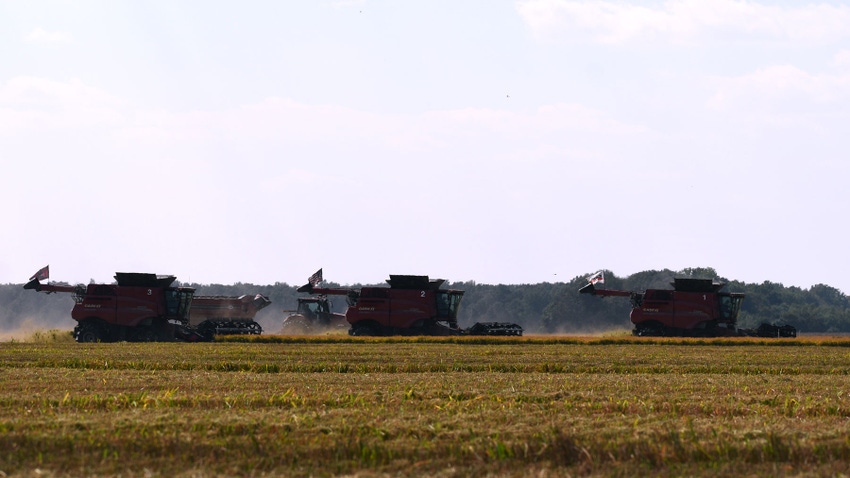
Midsouth farmers celebrated excellent rice yields in 2023. Arkansas and Missouri are each projected to set new records, with this year being the second-best yielding, just behind the top yields of 2021. While grain production was impressive, the milling quality is a different story.
Milling yields are down tremendously, and they became a perplexing topic of concern during harvest. The dry fall conditions of 2023 seemed to be a repeat of 2022 – when milling yields were significantly better. So, what weakened those rice kernels and impacted milling quality this year?
Jarrod Hardke, Extension rice agronomist at the University of Arkansas System Division of Agriculture, outlined a few environmental factors that contributed to lower milling yields in 2023. He noted that while high nighttime temperatures played a major role along the Gulf Coast, they were not as much the driving force in the upper Midsouth. Instead, he said, “The biggest driver for lower milling this year in the upper Midsouth was yet another dry fall.”
While there were similarities between this year’s harvest season and last, Jarrod discussed some considerable differences seen in Arkansas. Joining the conversation were RiceTec's U.S. marketing manager, Garrison Hardke and regional sales manager Jeff Mosely, whose territory covers Mississippi, Louisiana, and Texas.
Collectively, the three provided a Midsouth rice milling update for 2023.
Nighttime temperatures
Summer brought about prolonged periods of extreme heat and high nighttime temperatures. This was the case throughout the Rice Belt – from the Coastal Bend of Texas, over to south Louisiana, and upwards through Arkansas.
Mosely reported in south Louisiana alone, there were approximately 15 days of daytime temperatures topping 100 degrees Fahrenheit through the months of June and July. In the same timeframe, nighttime temperatures stayed above 80 degrees Fahrenheit for about 12 of those days. The rice crop could not catch a break.
“As long as those nighttime temperatures stay around 75 to 80 degrees, the rice plants do not get to rest or shut down from all the respiration taking place during the day,” Mosely explained. “When that happens, it tends to negatively affect milling qualities, particularly in head rice and to some extent totals.”
Ultimately, this gives rise to thinner kernels that break easily during the milling process. Garrison said the high nighttime temperatures of 2023 were red flags indicating lower milling quality. He affirmed in retrospect, “We saw the trainwreck coming.”
Recently, Garrison took the opportunity to review post-harvest milling yields by location with both Riceland and Producers rice mills. He said, “We looked at milling numbers on our RiceTec hybrids and different cultivars. Everything was off across the board compared to 2022.
“We had our fingers crossed that milling would improve as we moved north, and it did – but not as much as we needed it to.”
Same dry harvest, increased air moisture
Jarrod noted that nighttime temperatures were only a piece of the puzzle in the upper Midsouth. To him, the proof is in the chalk.
“We absolutely had bouts of high nighttime temperatures, but nothing compared to that experienced in Louisiana and the Gulf Coast region,” Jarrod said. “High nighttime temperatures tend to drive chalk up in rice, and rice mills have reported that chalk is not that high this year, which tells me nighttime temperatures were not the biggest driver for our lower milling yields in Arkansas and surrounding areas.”
Jarrod recalled the 2022 rice harvest that was incredibly dry with very limited air moisture, and he compared it to what we saw in 2023.
“We went through almost all of the 2022 harvest with zero rain, and we really did not have periods of heavy dew. We cut a lot of drier rice a year ago. Milling was on the low side but not awful,” Jarrod said.
In 2023, we saw a similar lack of rainfall and dry grain during the day. However, Jarrod noted that the humidity was much higher, contributing to heavier nighttime dews throughout harvest. This gave way to increased moisture cycling compared to last year.
“When the grain is dry and it gets rewetted then dries out again, it causes fissures and cracks to form in the grain. That is where lower head rice and lower milling come into play,” Jarrod explained.
Other factors influencing milling quality were timing and crop maturity. Garrison recalled the fast-paced planting season that inevitably bottlenecked harvest in 2023.
“We planted this crop in about two to three weeks,” Garrison said. “You cannot harvest it in two to three weeks. So, there was a lot of 13-14% moisture rice harvested. That is never good for milling quality.”
Winter grain hauling
Grain samples collected throughout the winter will likely improve the milling quality of the crop, since tempered rice from on-farm storage is generally expected to have better milling yields than rice delivered directly from the fields. Both of the Hardke brothers reported early indications of similar trends this coming winter.
Garrison said, “We typically expect milling to come up once rice has been in grain bins for a little while, and we are already seeing that. It just remains to be seen how much we can improve the overall quality of this crop.”
Likewise, more data will pour in, giving us a better understanding of the factors that led to this year’s milling situation.
Jarrod said, “These are not insights we know immediately. From a data standpoint, it takes a little while. As we get more data, everyone will feel better knowing the main drivers for lower milling. After this winter, we will have a better idea about which is the cart, and which is the horse.”
About the Author(s)
You May Also Like






